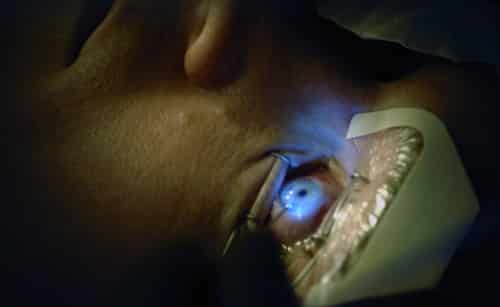Eye muscle repair surgery is a medical procedure carried out by orthoptists, who are experts in the movement of limbs or body parts, to rectify eye problems associated with muscle function. This surgery is especially performed when there is an unevenness among the muscles responsible for controlling eye movement.
Eye muscle issues commonly lead to Strabismus, a condition identified by the misalignment of the eyes, also referred to as cross-eyed, walleye, or squint. In case you encounter double vision, blurry vision, or observe that your eyes are not in sync (one might turn inward, outward, upward, or downward), it is possible that you are suffering from Strabismus, which may require surgical treatment to correct.

The goal of eye muscle repair surgery is to realign the muscles attached to the outside of the eye by strengthening or weakening them. This restores balance and allows equal use of both eyes, enhancing depth perception and visual function. Post-surgery, visual improvement can be significant leading to an increase in quality of life.
Types of Eye Muscle Repair Surgery
Corrective procedures for conditions affecting eye muscles are seeing great strides with the advent of modern medicine. Here is a concise review of the three most common kinds of eye muscle repair surgeries:
Strabismus surgery
This is a popular corrective procedure to rectify strabismus, a condition causing misalignment in the eyes. It involves adjusting the position of the eye muscles to ensure proper coordination.
Eye muscle recession
Often used when the eye turns inwards excessively, this procedure involves moving one or both ends of an eye muscle further back, making it less active.
Eye muscle resection
Eye muscle resection works by making the affected muscle more active. The surgeon does this by shortening and reattaching a muscle that often turns outward. This can restore balance and prevent future misalignment issues.
Extensive preoperative evaluation and discussion with your healthcare provider are critical before any surgical intervention.
Preparing for Eye Muscle Repair Surgery
Preparing for an eye muscle repair surgery can be an intriguing process, requiring thorough consultations, evaluations, and adherence to pre-operative instructions.
Consultation with an ophthalmologist
Communication: Before undergoing surgery, it’s crucial to consult with your ophthalmologist. This ensures informed decision making about the procedure and its potential benefits and risks.
Medical evaluations and tests
Examinations: Medical evaluations are part of preparing for eye muscle repair surgery. These might include various eye tests to assess your eye health and determine the kind of intervention needed.
Pre-operative instructions and considerations
Mandatory Instructions: Pre-operative guidelines, including dietary restrictions or the cessation of certain medications, are designed to increase the safety and effectiveness of the surgery. Your surgeon should provide these. Anticipate, understand, and follow them to ensure a successful operation.
The Procedure of Eye Muscle Repair Surgery
When it comes to corrective procedures pertinent to our visual prowess, Eye Muscle Repair Surgery is a promising choice. This surgical procedure aims to correct strabismus, wherein the eyes aren’t aligned properly.
Anesthesia options and monitoring
Going under: Eye muscle repair surgery is generally performed under general anesthesia, and vital signs are scrupulously monitored throughout the process.
Surgical techniques and instruments used
Modern instruments: The use of microscopic surgical tools aids in making a precise incision in the conjunctiva (outer layer of the eye), following which, surgeon proceeds onto the underlying eye muscles.
Repositioning and strengthening of eye muscles
Tightening move: The surgical team will either tighten, reposition or loosen the affected eye muscles to re-align the eyes. After correcting the problematic muscle, the conjunctiva is then stitched back using absorbable sutures.
Recovery and Post-operative Care
Overall Healing: Most patients will experience an immediate improvement in function with full recovery taking up to six weeks. During this time, you may notice slight changes in your vision.
Hassle-free Comfort: Post-operative discomfort is handled by over-the-counter pain medications, prescription medicines or both. It’s normal to experience some redness and swelling; however, should you have severe discomfort or sudden vision changes, seek medical attention immediately.
Note: this information can vary based on individual factors, like health status or the complexity of the surgery, always consult your surgeon for personalized care instructions.
Risks and Complications of Eye Muscle Repair Surgery
Eye muscle repair surgery is performed to correct strabismus (crossed eyes) or other eye-movement disorders. As with any operation, it has its potential risks and complications.
Potential risks and complications
The most common risks include:
- Infection: As with any surgery, there’s a risk of infection. Yet, it’s relatively low due to the antimicrobial eye drops applied post-surgery.
- Bleeding: Minimal bleeding during or after surgery can occur but is usually easily controlled.
- Overcorrection or undercorrection: These might require additional surgeries for adjustments.
- Double vision: This may occur temporarily after surgery; in rare cases, it can be permanent.
- Allergic reaction to anesthesia: Rare but potentially serious reactions can occur, including respiratory or cardiac distress.
Conclusion
Having undergone the journey of understanding eye muscle repair surgery, we arrive at a critical point – the benefits. This medical procedure aims to restore not only your vision but also your confidence and quality of life.